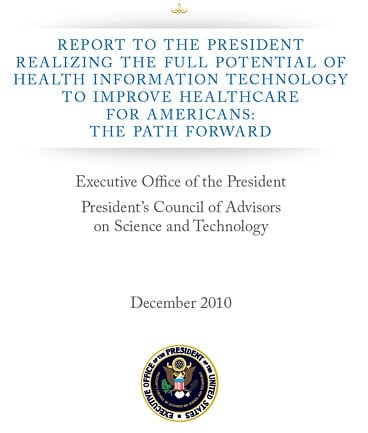As if Washington weren’t chock full of advisory groups, a new one has weighed in and its recommendations are sending shock waves through the health information technology (HIT) community. On December 8, 2010, the President’s Council of Advisors on Science and Technology (PCAST) released a report entitled, “Realizing the Full Potential of Health Information Technology to Improve Healthcare for Americans: The Path Forward.” In typical Washington fashion, it contained a bombshell tucked inside the 109 pages of verbiage.
The big news? PCAST’s report calls for the use of a Web-friendly “virtual exchange language” using tagged data. This would allow the exchange of electronic health records, regardless of format or source, using the universal language (PCAST recommends the Internet standard, XML). Each record would be tagged with metadata, which contain information to help identify patients, locate records and indicate privacy protections and access permissions.

The aim of the recommendations is to help achieve interoperability across the numerous data sources involved in patient care, promote rapid interoperability and ultimately facilitate public health reporting. Do the recommendations have legs? In our opinion, it’s a longer-term opportunity.
PCAST is an advisory group and its recommendations are, well, recommendations. There are no legislative or regulatory requirements attached to them at this point, so nobody has to do anything with them just yet. On the other hand, this is a very prestigious group comprised of a lot of heavy hitters in academia and representatives from Google (News  - Alert), Microsoft, the National Academy of Sciences and the National Academy of Engineering. Their ideas carry quite a bit of weight, so much so, in fact, that the federal Office of the National Coordinator (ONC) will convene a multi-stakeholder work group to conduct an in-depth review of PCAST’s report and make recommendations on implementation by April.
- Alert), Microsoft, the National Academy of Sciences and the National Academy of Engineering. Their ideas carry quite a bit of weight, so much so, in fact, that the federal Office of the National Coordinator (ONC) will convene a multi-stakeholder work group to conduct an in-depth review of PCAST’s report and make recommendations on implementation by April.
My company, Point of Care Partners (POCP) – like some others in the industry – find PCAST’s recommendations intriguing. And we – like some others – think this is where the industry is ultimately headed. But the devil is in the details, and time lines can be problematic. Payers, providers and vendors are struggling to implement HIPAA version 5010, ICD-10, and ePrescribing for controlled substances, much less being able to deal simultaneously with the evolving electronic health record (EHR) and meaningful use (MU) requirements of the recent reform legislation. As a result, implementing another set of far-reaching requirements cannot be accomplished anytime soon due to technical, budgetary and practical reasons. Doing so anytime soon would be an incredible burden that the industry would find almost impossible to meet. We also believe that if PCAST’s recommendations end up being folded into the MU requirements, it probably won’t be in Phase 2 as some have suggested. Perhaps, MU Phase 3 (or Phase 4?) and beyond would be a more likely scenario.
And what does this mean for the HIT industry? The recommendations certainly open the door to innovation by enabling entrepreneurs to create a whole new world of health care apps and modular software. This could be good for the entrepreneurs, but it could be a real shot across the bow for health information exchanges (HIEs) and monolithic EHR vendors. An example is software modularization, which the geeks define as “a segment of logical functionality” such as embedding ePrescribing in an EHR system. This kind of modularity is definitely a threat to these HIEs and big EMR vendors, as is the notion of easy sharing of data outside the walls of their infrastructures.
In addition, the health care industry operates in a much different environment than the software world. Things just don’t happen overnight in health care. Change comes slowly. Health care is highly regulated and the rule-making process can be lengthy and convoluted, translating into lengthy implementation time lines, especially for a change as expansive as this one. For example, how long has it taken to get regulations on versioning and updating for HIPAA transactions? Will the innovation envisioned by PCAST be slowed or strangled by bureaucracy? It’s also important to note that some other key issues will need to be addressed. For example, privacy and security fields may need to be augmented. Aggregation of longitudinal data is very complex. All this will take time, so it will be interesting to see if and how another government mandate will be laid across the shoulders of the health care industry.
MedHealthWorld analyzes the impact of EMR regulations and ePrescribing implementation on care providers, payers and patient quality of care.
Tony Schueth is founder, CEO and managing partner of Point-of-Care Partners, LLC, a health care information technology consulting firm. To read more of his articles, please visit his columnist page.Edited by
Jaclyn Allard